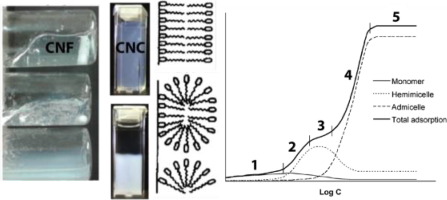Current Opinion in Colloid & Interface Science ( IF 7.9 ) Pub Date : 2017-03-01 , DOI: 10.1016/j.cocis.2017.02.004 Blaise L. Tardy , Shingo Yokota , Mariko Ago , Wenchao Xiang , Tetsuo Kondo , Romain Bordes , Orlando J. Rojas

|
Biomass-derived nanomaterials, such as cellulose nanocrystals and nanofibrils, are attractive building blocks for the formulation of foams, emulsions, suspensions and multiphase systems. Depending on their surface chemistry, aspect ratio and crystallinity, nanocelluloses can control the rheology and stability of dispersions; they can also confer robust mechanical properties to composites. Synthetic modification of fibrillar cellulose is an option to achieve chemical compatibility in related systems, in the formation of composites, etc. However, this can also limit the environmental benefits gained from the use of the cellulosic component. Thus, an attractive mean to compatibilize and to further expand the applications of nanocelluloses is through the use of surfactants. The chemical toolbox of surfactants developed over the last 60 years allows for a large versatility while their environmental impact can also be minimized. Furthermore, relatively small amounts of surfactants are sufficient to significantly impact the interfacial forces, which has implications in material development, from the colloidal scale to the macro-scale. In this review we attempt to cover the literature pertaining to the combined uses of surfactants and nanocelluloses. We summarize reports on the incorporation with nanocellulose of nonionic, anionic, amphoteric and cationic surfactants. With the ever-expanding interest in the use of renewable materials in a vast range of applications, we hope to provide insights into the application of surfactants as a tool to tailor the compatibility and the surface chemistry of nanocelluloses.
中文翻译:

纳米纤维素与表面活性剂的相互作用
生物质衍生的纳米材料,例如纤维素纳米晶体和纳米原纤维,是用于配制泡沫,乳液,悬浮液和多相系统的有吸引力的构建基块。取决于其表面化学,长径比和结晶度,纳米纤维素可以控制分散体的流变性和稳定性。它们还可以赋予复合材料强大的机械性能。纤维状纤维素的合成改性是在相关系统中,在复合材料的形成等中实现化学相容性的一种选择。但是,这也可能限制了使用纤维素组分所获得的环境效益。因此,通过使用表面活性剂来相容并进一步扩展纳米纤维素的应用是有吸引力的手段。过去60年开发的表面活性剂化学工具箱具有广泛的用途,同时也可以将其对环境的影响降至最低。此外,相对少量的表面活性剂足以显着影响从胶体规模到宏观规模的界面力,这对材料的发展具有影响。在这篇综述中,我们试图涵盖与表面活性剂和纳米纤维素联合使用有关的文献。我们总结了有关非离子,阴离子,两性和阳离子表面活性剂与纳米纤维素结合的报道。随着人们对可再生材料在广泛的应用中的兴趣不断扩大,我们希望提供对表面活性剂作为定制纳米纤维素的相容性和表面化学的工具的深刻见解。











































 京公网安备 11010802027423号
京公网安备 11010802027423号